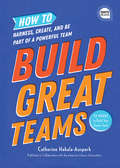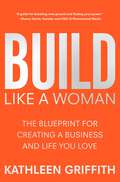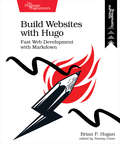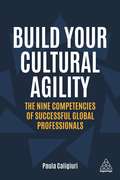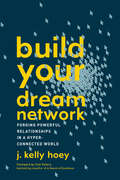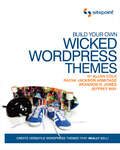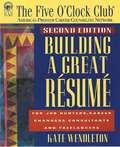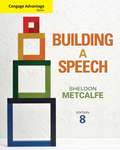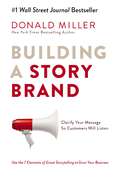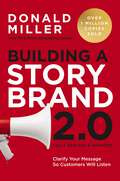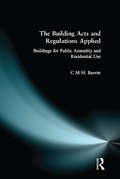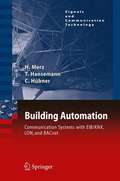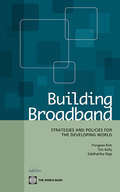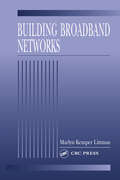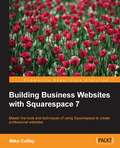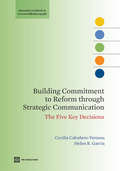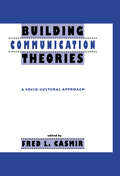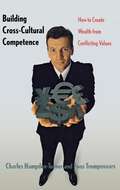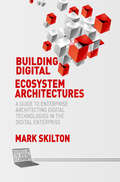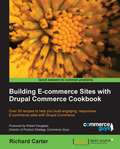- Table View
- List View
Build Great Teams: How to Harness, Create, and Be Part of a Powerful Team (Ignite Reads)
by American Library AssociationIn partnership with the American Library Association (ALA), Build Great Teams provides a 52-week guide to creating your dream team—and accomplishing each of your goals along the way!Teamwork matters. Most of us realize the immediate impact of being on a strong, cohesive and harmonious team. But how do you A) establish a powerhouse team; B) develop successful teamwork skills; and C) turn a troubled team around?In just one year (or 52-weeks), you can achieve your personal dream team through Catherine Hakala-Ausperk's proven program. Organized in 52 modules, designed to cover a year of weekly sessions but easily adaptable for any pace, this work covers major management topics such as success with recruiting, ensuring roles are successful, team communication, establishing an innovative team, and more!
Build Like A Woman: The Blueprint for Creating a Business and Life You Love
by Kathleen GriffithFrom the self-made businesswoman and founder of the global platform Build Like A Woman comes the essential resource to unleash your business, take up space, and create your dream life.In a world of hustle culture and burnout, women don’t want to lean in, they want to lie down. Now more than ever, women are looking to leave the corporate grind to break out into their own entrepreneurial ventures in a way that feeds their life rather than consumes it. But they don’t know exactly where to start.Kathleen Griffith has been in these exact shoes. When she set out to launch her own business she found that the women’s business space was big on “go, girl” messages, but short on the gritty details of actually building a business. So she taught herself everything she could, learned from the best minds in business and coached with personal growth experts. She realized, shockingly, that all the “mindset” work paid the highest dividends of all in her business, and that through this process she had developed a proven method for success.Blending foundational mindset tenets with the practical, actionable, business-building skillsets, Build Like A Woman is for aspiring and existing entrepreneurs who want to start and scale a business AND life they love. From corporate dropouts to side hustlers to recent college grads to full-fledged founders. This is not a regular business book, but an unconventional blueprint for creation. It will shake up any belief that’s holding you back, remove any barriers standing in your way and unlock your full potential. Tools you’ll get to break ground in business and break through in life:● Life Design● Wellness Practices ● Personal Power ● Mindful Leadership ● Money Management ● Customer Target● Brand Strategy● Marketing Plan● Sales Pitch Are you ready to BUILD? Let’s dig in.
Build Websites with Hugo: Fast Web Development With Markdown
by Brian P. HoganDatabase-driven sites bring complexity you might not need, but building a site by hand is too much work. Hugo is a static site generator and web development framework that creates content sites quickly without the overhead or dependencies of a dyanmic web framework. With Hugo, you use HTML templates and Markdown to build static sites you can host anywhere, letting you use the skills you already have. Develop your own theme using standard HTML and CSS, using Hugo’s powerful templating features to organize your site’s components. Create your site’s content with HTML or Markdown and use Hugo’s content templating features to build new content quickly. Build a fully-featured blog with archive pages, tagging, and pagination, and integrate an external commenting system to provide interactivity. Use data from front-matter, site-wide configuration, and external JSON sources to add content, and generate JSON others can use. Integrate JavaScript with your site to create a search engine. Get Hugo working with Webpack so you can leverage the wider web development ecosystem, and explore ways to publish your site to various services. Finally, learn how you can move your existing content site to Hugo. Dive in and build your next site with Hugo!
Build Your Cultural Agility: The Nine Competencies of Successful Global Professionals
by Paula CaligiuriThe investment in global collaboration technology now exceeds US$45 billion. Professionals who work across cultures face some of the most cognitively, psychologically and emotionally difficult challenges, regardless of whether they work virtually or in person. And they often face these challenges without the help of a corporate guide. Build Your Cultural Agility is that guide. This book offers strategies to help you develop into a successful global professional, one who can comfortably and effectively work in and with people from different cultures. This book helps you leverage your natural strengths while providing suggestions for developing cultural agility competencies. Build Your Cultural Agility focuses on nine specific competencies that comprise cultural agility: three self-management competencies (tolerance of ambiguity, curiosity and resilience), three relationship-management competencies (humility, relationship-building and perspective-taking) and three task-management competencies (cultural minimization, cultural adaptation and cultural integration). Within each chapter, the author provides a case example of that competency in action, explains why the competency is critical for success, offers a self-awareness exercise to help you determine your level of proficiency and concludes with suggestions for self-development.
Build Your Dream Network: Forging Powerful Relationships in a Hyper-Connected World
by Kelly HoeyCut through the networking noise and start building the powerful, real relationships needed to succeed in our digital world If you think of networking as schmoozing at boring cocktail parties or scrolling through LinkedIn for new contacts to add, think again. In the social media age, you need a modern roadmap for creating and cultivating meaningful connections to stand out from the crowd and achieve any of your goals, no matter how big or small. In Build Your Dream Network, acclaimed business columnist and networking expert J. Kelly Hoey offers a fresh new approach to mastering this timeworn skill in a world where everyone is posting, liking, and friending fast and furiously, but many are failing to leverage their connections successfully. Hoey presents innovative strategies for forming strong relationships—the genuine, mutually beneficial, long-lasting kind—using all of the social tools at your disposal. She also reveals creative and surprisingly simple ways to harness the power of your network to accomplish any ambition, from landing your dream job or a coveted account or client to successfully crowdfunding a new business venture. Build Your Dream Network will help you: • Determine the most effective ways to connect with others so you don’t clutter your calendar with dead-end coffee dates and informational interviews • Synchronize IRL networking efforts with your digital outreach • Turn “closed door” conversations into strong personal relationships and business opportunities • Eliminate FOMO by keeping your networking efforts focused Packed with infographics, flowcharts, and encouraging advice, Build Your Dream Network shows how small adjustments in your daily routine, generosity, and goal-focused efforts are all it takes to set you apart and ignite the powerful connections that will lead to major opportunities for success.
Build Your Own Wicked Wordpress Themes: Create Versatile Wordpress Themes That Really Sell!
by Alan Cole Raena Jackson Armitage Brandon R. Jones Jeffrey WayWicked WordPress Themes is a step-by-step guide to creating beautiful themes for the world's most popular CMS, WordPress.By following the book's advice, readers can produce designs that are aesthetically stunning, consistent, and for-purpose -whether it's for their own use, or to drive a high price on the theme marketplace.All facets of theme design are covered: from design, coding, and deployment, to ensuring readers' designs are ready-to-go as soon as they're installed. Wicked WordPress Themes teaches readers how to leverage theme design frameworks to dramatically shorten development time, enabling them to enter the theme market faster.
Building a Great Resume: For Job Hunters, Career Changers, Consultants, and Freelancers (2nd edition)
by Kate WendletonThe average resume is only looked at for ten seconds. Would you like yours to stand out? Would you like to learn how to highlight your strengths and hide your weaknesses? Would you like a marketing piece that dynamically presents you just the way you want prospective employers to see you? BUILDING A GREAT RESUME starts with an overview of The Five O'clock approach to job search. You'll learn to develop the accomplishment statements that form the backbone of your resume. You'll learn the most effective ways to present your experience. You'll learn how to write a summary that increases your chances of getting just the job you want. Your resume will be more exciting to the reader. BUILDING A GREAT RESUME helps you see the theory in practice by showing you scores of sample resumes. And this is the only resume book on the market to bring you case studies that teach you the nuances of how to think about resume preparation. The book is fully indexed by industry and profession so you can easily find the resumes that pertain to you. BUILDING A GREAT RESUME is based on the highly successful methods used at The Five O'clock Club, America's Premier Career Counseling Network, where the average participant finds a new job in less than 10 weeks. Kate Wendleton, a nationally syndicated careers columnist, is an authority on job search and career development. Kate has been a career coach since 1978 when she rounded The Five O'clock Club to help job hunters, career changers, and consultants at all levels. She is also the founder of-Workforce America, a not-for-profit organization serving adult job hunters in Harlem who are not yet in the professional or managerial ranks. A former CEO of two small companies. Kate has twenty years of business experience as well as an MBA.
Building a Speech (Cengage Advantage Books)
by Sheldon MetcalfeWith 19 chapters organized into five units, BUILDING A SPEECH, 8th EDITION guides students through the step-by-step process of developing public speaking skills through observation, peer criticism, personal experience and instructor guidance. Readings and exercises help students draft informative and persuasive speeches and improves their research and speechwriting skills. Topics such as apprehension and listening help students realize that they are not alone in their struggle to find the confidence to speak in public. BUILDING A SPEECH is grounded in the philosophy that students can master the steps of speech construction when provided with a caring environment, clear direction, and creative examples.
Building a StoryBrand: Clarify Your Message So Customers Will Listen
by Donald MillerNew York Times bestselling author Donald Miller uses the seven universal elements of powerful stories to teach readers how to dramatically improve how they connect with customers and grow their businesses.Donald Miller’s StoryBrand process is a proven solution to the struggle business leaders face when talking about their businesses. This revolutionary method for connecting with customers provides readers with the ultimate competitive advantage, revealing the secret for helping their customers understand the compelling benefits of using their products, ideas, or services. Building a StoryBrand does this by teaching readers the seven universal story points all humans respond to; the real reason customers make purchases; how to simplify a brand message so people understand it; and how to create the most effective messaging for websites, brochures, and social media. Whether you are the marketing director of a multibillion dollar company, the owner of a small business, a politician running for office, or the lead singer of a rock band, Building a StoryBrand will forever transform the way you talk about who you are, what you do, and the unique value you bring to your customers.
Building a StoryBrand 2.0: Clarify Your Message So Customers Will Listen
by Donald MillerWhen you apply the StoryBrand framework your brand will stand out. Developing that framework to clarify your message and grow your business is about to get a whole lot simpler. . .Since the original publication of Building a StoryBrand, over one million business leaders have discovered Donald Miller's powerful StoryBrand framework, and their businesses are growing. Now, the classic resource for connecting with customers has been fully revised and updated, making it an even more powerful tool to prepare you to engage customers.In a world filled with constant, on-demand distractions, it has become very hard for business owners to effectively cut through the noise to reach their customers. Without a clear, distinct message, customers will not understand what you can do for them and won't engage.In Building a StoryBrand 2.0, Donald Miller not only deepens his teaching on how to use his seven universal story elements—he'll provide you with one of the most powerful and cutting-edge tools to help with your brand messaging efficacy and output.The StoryBrand framework is a proven process that has helped thousands of companies engage with their existing customers, giving them the ultimate competitive advantage. Now you can have access to the perfected version, making it more essential.Whether you are the marketing director of a multibillion-dollar company, the owner of a small business, a politician running for office, or the lead singer of a rock band, Building a StoryBrand 2.0 will forever transform the way you talk about who you are, what you do, and the unique value you bring to your customers.
Building a Workplace Writing Center: A Sustainable Solution and Practical Guide
by Jessica Weber MetzenrothThis practical resource provides guidance for writing professionals to sustainably tackle the organizational writing challenges of any professional environment. Rooted in applied experience, Building a Workplace Writing Center guides readers through the process of developing a writing center, from assessing the needs of an organization and pitching the idea of a writing center, to developing a service model and measuring progress. Chapters explore what a writing center can offer, such as one-on-one writing consultations, tailored group workshops, and standardized writing guidance and resources. Although establishing a writing center requires time and a shift in culture up front, it is a rewarding process that produces measurably improved writing, less frustration with the writing and revision processes, and more confident, independent writers. This guide is an invaluable resource for professionals across industries and academia considering how to establish an embedded, sustainable, and cost-effective workplace writing center. It will be of particular interest to business and human resource managers considering how best to improve writing skills within their organizations.
The Building Acts and Regulations Applied: Buildings for Public Assembly and Residential Use
by C.M.H. BarrittThis book forms part of a unique, highly practical and time-saving three volume presentation of the Building Regulations, each book covering all the regulations relating to specific building usage. The chapters of each volume form self-contained units covering all the Regulation requirements applicable to a particular part of a building; thus the reader can ensure that all the Regulations are fully met. Also included is a digest of published standards, guides and technical information as well as reviews of the new Eurocodes currently being introduced.The Building Acts and Regulations Applied: Buildings for Public Assembly and Residential Use covers all the regulations relating to buildings used for public assembly or residential purposes (other than houses and flats), such as theatres, sports stadia, hotels, prisons and halls of residence. It is a useful course companion for BTEC HNC/D and degree courses in building, architecture, surveying, estate management and other built environment disciplines. It is also an ideal reference source for all professionals working in these areas.
Building and Negotiating Religious Identities in a Zen Buddhist Temple: A Perspective of Buddhist Rhetoric
by Fan ZhangThis book explores the practices in a Zen Buddhist temple located in Northwest Ohio against the backdrop of globalization. Drawing on the previous studies on Buddhist modernization and westernization, it provides a better understanding of the westernization of Buddhism and its adapted practices and rituals in the host culture. Using rhetorical criticism methodology, the author approaches this temple as an embodiment of Buddhist rhetoric with both discursive and non-discursive expressions within the discourses of modernity. By analyzing the rhetorical practices at the temple through abbots’ teaching videos, the temple website, members’ dharma names, and the materiality of the temple space and artifacts, the author discovers how Buddhist rhetoric functions to constitute and negotiate the religious identities of the community members through its various rituals and activities. At the same time, the author examines how the temple’s space and settings facilitate the collective the formation and preservation of the Buddhist identity. Through a nuanced discussion of Buddhist rhetoric, this book illuminates a new rhetorical methodology to understand religious identity construction. Furthermore, it offers deeper insights into the future development of modern Buddhism, which are also applicable to Buddhist practitioners and other major world religions.
Building Automation: Communication systems with EIB/KNX, LON and BACnet (Signals and Communication Technology)
by Christof Hübner James Backer Leena Greefe Thomas Hansemann Viktoriya Moser Hermann MerzModern buildings are increasingly equipped with actuators and sensors, communication, visualization and control systems. This textbook provides an overview of industrial communication systems and stimulates a basic understanding of network and bus systems for the automation of buildings. After an introduction to EIB/KNX, LON und BACnet technologies, the authors illustrate how these systems can be utilized for specific applications, like air conditioning or illumination. This book assumes only a basic knowledge of mathematics and thanks to its simple explanations and many examples is ideal for students and professional engineers who require practical solutions.
Building Broadband: Strategies and Policies for the Developing World
by Siddhartha Raja Yongsoo Kim Tim KellyAccess to broadband connectivity is a country's passport to the global information society and knowledge economy of the future. However, the adoption and use of broadband technology today remains extremely uneven and threatens to create a new digital divide. At the end of 2009, countries in North America and the European Union accounted for more than 50 percent of the world's 1 billion fixed and mobile broadband subscriptions, but South Asia and Sub-Saharan Africa together accounted for less than 3 percent. The experience with mobile telephony though shows the potential for growth in the information and communication technology sector in developing countries. Almost 75 percent of the world's mobile telephone subscriptions are in low- and middle-income countries, which have also promoted exciting innovations and realized significant economic development benefits. In fact, a growing number of countries are seeking to spur broadband development. To aid governments as they design their own programs, this volume offers examples and ideas from some of the most successful broadband markets: particularly the Republic of Korea, but also Finland, France, Japan, Sweden, the United Kingdom, and the United States. 'Building Broadband' does not suggest a universal solution but rather provides a long list of policies and programs organized within a strategic framework that allows solutions tailored to country circumstances. The essential building blocks identified are useful everywhere because they focus on improving incentives and the climate for private investment. This is a policy that even countries with very limited resources will be able to exploit.
Building Broadband Networks
by Marlyn Kemper LittmanOptical networks, undersea networks, GSM, UMTS The recent explosion in broadband communications technologies has opened a new world of fast, flexible services and applications. To successfully implement these services, however, requires a solid understanding of the concepts and capabilities of broadband technologies and networks.Building Br
Building Business Websites with Squarespace 7
by Miko CoffeyThis book is ideal for anyone who wants to learn how to use the latest version of Squarespace to create a website from scratch and take it through to go-live. You don't need any prior experience with Squarespace, HTML or CSS, or building websites in general as everything is done using Squarespace's simple, browser-based interface.
Building Business Websites with Squarespace 7 - Second Edition
by Miko CoffeyDiscover the best way to build, design and launch professional websites with Squarespace quickly, without needing to learn any code About This Book • Discover time-saving tricks and best practices, and avoid common pitfalls while creating a website • Create visually stunning Responsive Design templates for your website with Squarespace 7 • Understand how to monitor, measure, and manage your website after launching it Who This Book Is For This book is ideal for anyone who wants to learn how to use the latest version of Squarespace to create a website from scratch and take it through to go-live. You don't need any prior experience with Squarespace, HTML, or CSS, or building websites in general as everything is done using Squarespace's simple, browser-based interface. What You Will Learn • Develop an essential Website Toolkit that will act as reference and materials for your entire project, ensuring you stay on-target to meet your objectives • Set up your Squarespace account, learn how the interface works, and select the correct template for your website's purpose and goals • Create your website framework, fill it with content, and arrange your pages using Squarespace's easy drag-and-drop tools • Customize your site's look and feel to match your brand, and create a stunning visual impact for your website on all types of devices, including mobiles and tablets • Configure the core functions your business needs, whether connecting to social media, promoting events, showcasing your work, or selling goods and services online • Learn time-saving tricks and how to avoid common pitfalls from an experienced professional with years of Squarespace experience • Gain valuable insights about search engine optimization, communicating effectively online, and other e-marketing advice • How to monitor, measure, and manage your website post-launch In Detail Squarespace is a web-based tool that allows non-technical people to create and manage professional-looking websites quickly, without needing to write any code. It empowers business owners to take total control of their own websites, without needing to pay someone to design or maintain it. This book covers much more than just how to use Squarespace. It covers all aspects of creating a successful business website, from developing your brand identity, to writing and structuring content to match your target audience's needs, and dozens of other other valuable tips that will help your website shine. Most importantly, you'll learn the correct steps to follow in order to ensure your project is smooth and stress-free. The book starts by helping you plan your website project and gather all the raw materials you'll need. Next, you'll set up your account and become familiar with the terminology and tools that you'll be using. Once you've learned the basics of how the Squarespace interface, templates, and different page types operate, you will create the framework of your website, ready for you to insert content and functionality. Then, once all the core elements are in place, you'll apply the aesthetic fine-tuning needed to bring your website in line with your brand. After the aesthetics have been honed and all functions tested, you will launch your website and drive traffic to it, monitor it, and improve it. Style and approach This easy-to-follow guide will teach you to build websites the easiest way in the latest version of Squarespace.
Building Commitment to Reform through Strategic Communication
by Helen R. Garcia Cecilia Cabañero-VerzosaStrategic communication is a powerful tool for creating broad-based support for reform and change initiatives. Much has been written about why communication matters in reform efforts, but there is scant material available to help those who manage reforms apply communication concepts and approaches to their own programs and policy-reform initiatives. 'Building Commitment to Reform through Strategic Communication' attempts to bridge that gap. The authors present a pragmatic and systematic approach for reformers ready to use communication strategically to achieve their reform goals. The Five Communication Management Decision Tool helps reformers and their teams develop a framework for their communication strategies. This decision tool helps managers see change initiatives through the eyes of those who will be affected by the reforms. When the decision tool is used in the early stages of the development of change programs, reformers gain an even deeper understanding of the stakeholders' perspectives on the reforms, which influence stakeholder opposition or support for them. Such understanding will not only be instructive, but possibly transformative-for both change agents and those stakeholders whose support is critical to the success of reform. Reform agents may recognize the source of stakeholder resistance and be able to revise reform goals and redesign change interventions. Stakeholders who have a shared understanding of why the status quo is not acceptable and change is necessary are more likely to create coalitions of committed allies and supporters who will work together to achieve reform goals. This workbook illustrates how the decision tool can be used for various types of change and reform initiatives-from policy reform, to country and donor partnership agreements, to sectoral reforms. Tested and used in learning interventions across cultures, regions, and sectors, the tool has been used successfully by teams in government, nongovernmental organizations, the business sector, and donor agencies. The book will be of great interest to readers working in all of these areas.
Building Communication Theories: A Socio/cultural Approach (Routledge Communication Series)
by Fred L. CasmirConcern with various matters related to humans as they communicate has led to an increase in both research and theorizing during the second half of the 20th century. As a matter of fact, so many scholars and so many disciplines have become involved in this process that it is virtually impossible to understand and appreciate all that has been accomplished so far. This book focuses on one important aspect of human sense-making -- theory building -- and strives to clarify the thesis that theories do not develop in some sort of social, intellectual, or cultural vacuum. They are necessarily the products of specific times, insights, and mindsets. Theories dealing with the process of communication, or communicating, are tied to socio-cultural value systems and historic factors that influence individuals in ways often inadequately understood by those who use them. The process-orientation of this book inevitably leads to an emphasis on the perceptions of human beings. Thus, the focus shifts from the subject or area called "communication" to the act of communicating. Finally, this volume offers insight into how the process of human sense-making has evolved in those academic fields commonly identified as communication, rhetoric, speech communication or speech, within specific socio-cultural settings.
Building Cosmopolitan Communities
by Amos NascimentoBuilding Cosmopolitan Communities contributes to current cosmopolitanism debates by evaluating the justification and application of norms and human rights in different communitarian settings in order to achieve cosmopolitan ideals. Relying on a critical tradition that spans from Kant to contemporary discourse philosophy, Nascimento proposes the concept of a "multidimensional discourse community. " The multidimensional model is applied and tested in various dialogues, resulting in a new cosmopolitan ideal based on a contemporary discursive paradigm. As the first scholarly text to provide an interdisciplinary survey of the theories and discourses on human rights and cosmopolitanism, Building Cosmopolitan Communities is a valuable resource to scholars of philosophy, political science, social theory, and globalization studies.
Building Cross-Cultural Competence: How to Create Wealth from Conflicting Values
by Charles Hampden-Turner Fons Trompenaars David LewisBased on 14 years of research involving nearly 50,000 managerial respondents and on the authors' extensive experience in international business, this book uses humor, cartoons, and numerous business examples to show managers how to reconcile cultural differences in the workplace.
Building Cybersecurity Applications with Blockchain and Smart Contracts (Signals and Communication Technology)
by Nour El Madhoun Ioanna Dionysiou Emmanuel BertinThis book offers an in-depth exploration of the application of blockchain and smart contract technologies in the field of cybersecurity. It begins by defining the fundamentals of cybersecurity in the context of blockchain and smart contracts, and then moves on to the world of e-government services, describing how blockchain can enhance the security of these services. The book also explores how blockchain can secure the Internet of Things (IoT), focusing on applications such as securing drones and protecting robotic networks. The importance of scalability in distributed replication systems is also discussed, with a particular focus on sharding. Finally, the book looks at the challenges of data protection in distributed ledger and blockchain technologies, providing both an analysis of the problems and solutions. Written by academic researchers and industry experts, this book offers a comprehensive and nuanced perspective on the transformational potential of blockchain and smart contracts in the field of cybersecurity.
Building Digital Ecosystem Architectures: A Guide to Enterprise Architecting Digital Technologies in the Digital Enterprise (Business in the Digital Economy)
by Mark SkiltonThe design of digital solutions has become a pressing concern for practitioners faced with a plethora of technology impacting their business. From cloud computing to social networks, mobile computing and big data, to the emerging of Internet of things, all of which are changing how enterprise products, services, rooms and buildings are connected to the wider ecosystem of networks and services. This book defines digital ecosystems with examples from real industry cases and explores how enterprise architecture is evolving to enable physical and virtual, social, and material object collaboration and experience. The key topics covered include:Concepts of digitizationTypes of technological ecosystemsArchitecting digital workspaces Principles of architecture design Examples architecting digital business models Examples of digital design patterns Methods of monetizationConclusions
Building E-commerce Sites with Drupal Commerce Cookbook
by Richard CarterBuilding eCommerce Sites with Drupal Commerce Cookbook is written in a helpful, practical style with numerous hands-on recipes to help you build attractive eCommerce sites.This book is primarily for store owners and web designers with little or no experience of Drupal and Drupal Commerce who want to build and customise a store in Drupal Commerce. You will have a basic knowledge of websites, but you don't need to be familiar with Drupal or PHP. However, this book would also suit experienced Drupal and Ubercart users who want to migrate to or build a Drupal Commerce store
